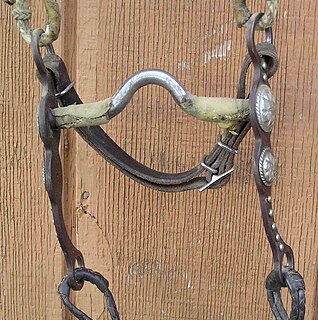
A bridle is a piece of equipment used to direct a horse. As defined in the Oxford English Dictionary, the "bridle" includes both the headstall that holds a bit that goes in the mouth of a horse, and the reins that are attached to the bit.

A halter or headcollar is headgear that is used to lead or tie up livestock and, occasionally, other animals; it fits behind the ears, and around the muzzle. To handle the animal, usually a lead rope is attached. On smaller animals, such as dogs, a leash is attached to the halter.

A pelham bit is a type of bit used when riding a horse. It has elements of both a curb bit and a snaffle bit. In this respect a pelham bit functions similar to a double bridle, and like a double bridle it normally has "double" reins: a set of curb reins and a set of snaffle reins. Because it has a bit shank and can exert curb-style pressure on the horse, it is considered a curb bit. Like all curb bits, a pelham bit has a mouthpiece, shanks with both purchase and lever arms, a ring for rein attachment at the bottom of the shank, and a curb chain. But like a snaffle bit, a pelham bit also has a bit ring on either side of the mouthpiece. Like some curb bits, a pelham bit usually has "loose" shanks - hinged at the mouthpiece in the same way that the rings of a snaffle bit are hinged. When two sets of reins are used, the snaffle rein generally is wider, to help distinguish it from the curb. A "cowboy pelham" is a western style of loose-jawed curb bit with additional rings at the mouthpiece allowing a second set of reins to be added.
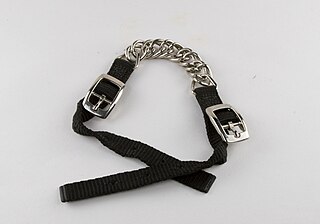
A curb chain, or curb strap, is a piece of horse tack required for proper use on any type of curb bit. It is a flat linked chain or flat strap that runs under the chin groove of the horse, between the bit shank's purchase arms. It has a buckle or hook attachment and English designs have a "fly link" in the middle to hold a lip strap. On English bridles the horse is bridled with the curb chain undone on one side, then connected once on the horse. On western bridles, the curb chain is kept buckled to both sides of the bit.

A snaffle bit is the most common type of bit used while riding horses. It consists of a bit mouthpiece with a ring on either side and acts with direct pressure. A bridle utilizing only a snaffle bit is often called a "snaffle bridle", particularly in the English riding disciplines. A bridle that carries two bits, a curb bit and a snaffle, or "bradoon", is called a double bridle.
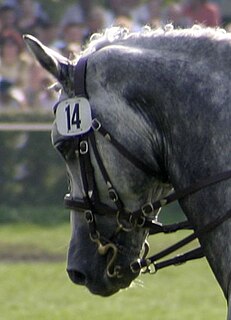
A double bridle, also called a full bridle or Weymouth bridle, is a bridle that has two bits and four reins. One bit is the bradoon, is a modified snaffle bit that is smaller in diameter and has smaller bit rings than a traditional snaffle, and it is adjusted so that it sits above and behind the other bit, a curb bit. Another term for this combination of curb and snaffle bit is a "bit and bradoon", where the word "bit" in this particular context refers to the curb.
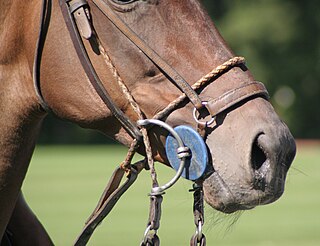
The gag bit is a type of bit for a horse. Because the cheek piece and reins attach to different rings there is leverage action. Severity of leverage action depends on where the reins attach. For example, in a Dutch Gag, the further the rein attachment from the mouthpiece the greater the leverage. The gag bit is related to a Pelham bit and a double bridle but the gag bit has no curb strap.
A martingale is any of several designs of tack that are used on horses to control head carriage. Martingales may be seen in a wide variety of equestrian disciplines, both riding and driving. Rules for their use vary widely; in some disciplines they are never used, others allow them for schooling but not in judged performance, and some organizations allow certain designs in competition.

Reins are items of horse tack, used to direct a horse or other animal used for riding. They are long straps that can be made of leather, nylon, metal, or other materials, and attach to a bridle via either its bit or its noseband.

A hobble or spancel is a device which prevents or limits the locomotion of a animal, by tethering one or more legs. Although hobbles are most commonly used on horses, they are also sometimes used on other animals. On dogs, they are used especially during force-fetch training to limit the movement of a dog's front paws when training it to stay still. They are made from leather, rope, or synthetic materials such as nylon or neoprene. There are various designs for breeding, casting, and mounting horses.

A hackamore is a type of animal headgear which does not have a bit. Instead, it has a special type of noseband that works on pressure points on the face, nose, and chin. It is most commonly associated with certain styles of riding horses.
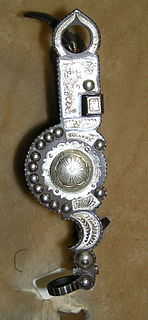
The bit shank is the side piece or cheekpiece of a curb bit, part of the bridle, used when riding on horses. The bit shank allows leverage to be added to the pressure of the rider's hands on the bit. Shanks are usually made of metal, may be straight or curved, and may be decorated in some disciplines. The headstall and curb chain or curb strap of the bridle is attached to the top of the shank, and the reins are attached at the bottom. Shanked curb bits are used in western riding for nearly all adult horses, and are seen in English riding disciplines primarily as part of the double bridle used by advanced dressage riders, and on the hybrid pelham bit that includes a ring for a second rein attached at the bit mouthpiece.

A mechanical hackamore is a piece of horse tack that is a type of bitless headgear for horses where the reins connect to shanks placed between a noseband and a curb chain. Other names include "hackamore bit", "brockamore", "English hackamore", "nose bridle" and "German hackamore". Certain designs have been called "Blair's Pattern" and the "W. S. Bitless Pelham".
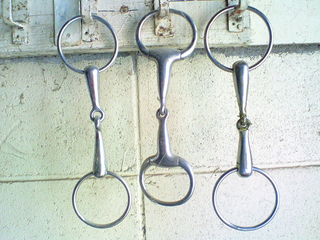
The bit ring is the ring on the side of a horse's bit, particularly on a snaffle bit. It is used as a point of attachment for the cheekpieces of the bridle and for the reins. It also has an effect on the action of the bit. Therefore, the design of the ring is something to consider when choosing a bit for a horse, even though the bit mouthpiece generally has a greater effect than the ring.

A bit is a type of horse tack used in equestrian activities, usually made of metal, or a synthetic material. It is placed in the mouth of a horse and assists a rider in communicating with the animal. It extends from one side of the mouth across to the other and rests on the bars of the mouth, which are a region, between the incisors and the molars, where there are no teeth. It is held on a horse's head by means of a bridle and has reins attached for use by a rider.

A horse harness is a type of horse tack that allows a horse or other equine to be driven and to pull various horse-drawn vehicles such as a carriage, wagon or sleigh. Harnesses may also be used to hitch animals to other loads such as a plow or canal boat.

A bitless bridle is a general term describing a wide range of headgear for horses or other animals that controls the animal without using a bit. Direction control may also be via a noseband or cavesson, if one is used. The term hackamore is the most historically accurate word for most common forms of bitless headgear. However, some modern bitless designs of horse headgear lack the heavy noseband of a true hackamore and instead use straps that tighten around a horse's head to apply pressure in various ways. These are often specifically patented and marketed as "bitless bridles", usually referencing a particular type of headgear known as the cross-under, though other designs are sometimes also given similar names.

A frentera is a part of some halters and bridles, usually on a horse. It is a cord, strap, or chain on the face of the horse that is attached to the crownpiece or browband and runs down the horse's face to the noseband or bit rings. A frentera can be split at the top to pass on either side of the forelock, or on either side of the ears. In the latter case, the frentera usually substitutes for a browband. A frentera can also be split at the bottom into two or more parts to support and stabilize a heavy noseband or bit.



